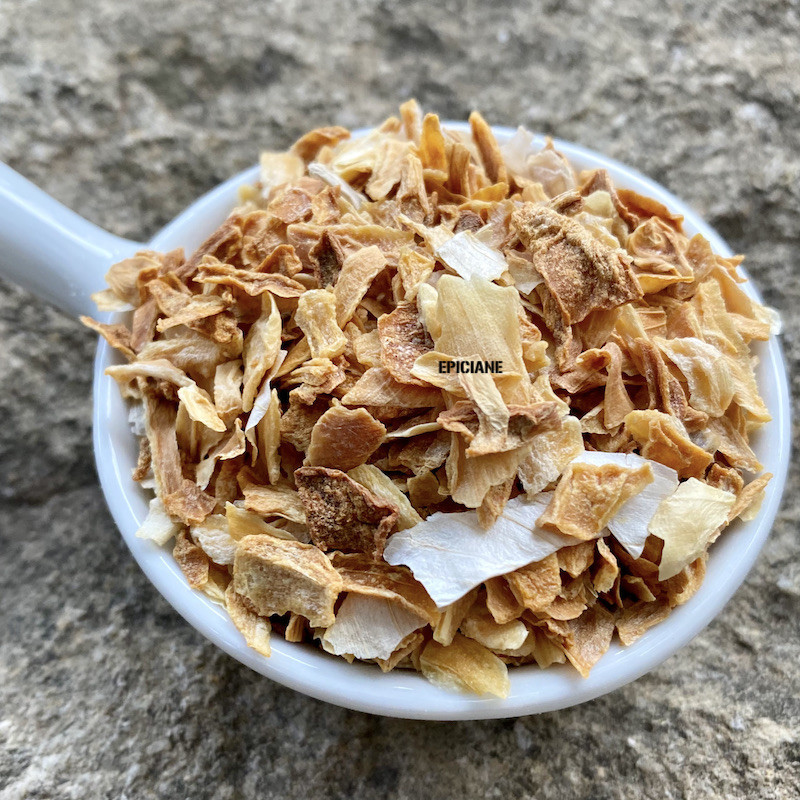
Reference: EPI2301001


Grilling onion enhances its flavor and gives it a pleasant "cooked" taste. It becomes very digestible, much more so than raw onion.
Perfect for all your cooked dishes or salads, it's already peeled, chopped, and instantly ready—no tears from peeling or lingering smell on your fingers...!!!
 Delivery
Delivery
Mondial Relay
 Returns
Returns
See conditions
 Payments
Payments
100% secure
Livré en sachet refermable
Culinary Uses:
For reference, 1 kg of this product is equivalent to about 8 kg of peeled onion.
The onions are first sliced, dehydrated, and then toasted. This grilled form allows you to add it to any dish without peeling—a task that often causes tears and leaves an odor on your hands! Simply sprinkle it over your dish while cooking, and it’s ready in moments. No tears, no lingering smell on your hands or in the kitchen!
Once rehydrated (in a sauce or a bit of water for a salad), it will have the same characteristics as cooked fresh onion. Its delightful "cooked" flavor is especially recommended for sauces and meats, where it becomes quickly ready and is very digestible compared to fresh onion!
For salads, it's best to rehydrate it for a few minutes with a little water before making your dressing, so it becomes soft.
Onion (like shallots and garlic) is truly essential in cooking. It’s used worldwide, both raw and cooked. Almost no dish is complete without it! There are many varieties, all delicious.
The molecule responsible for making you cry, highly volatile and released into the air when peeling a raw onion, is water-soluble, which is why you don’t cry as much if you moisten the onion or the knife blade regularly. Effective, but a bit inconvenient nonetheless!
Who am I?
Origin: India
The onion is a herbaceous plant in the large allium family, like garlic, shallot, chives, and leek. The hollow flower stem reaches 60 cm to 1 meter, with a terminal spherical flower at its tip. In some varieties, small bulbs replace flowers, as with the Rocambole onion. The leaves are also green, cylindrical, and hollow. The plant’s bulb is relatively large, spherical, and sometimes slightly flattened.
While its wild ancestor remains unknown, its origin is believed to be in southwestern Asia. It is likely one of the oldest cultivated vegetables in the world. Today, it is produced in all temperate regions globally.
Through its historical journey, the onion has diversified in forms, sizes, flavors, and colors, adapting to different climates, cultivation methods, and local culinary traditions.
Recent studies indicate that regular onion consumption may reduce the risk of certain cancers and slow cancer cell growth. It also has a beneficial effect on cardiovascular risk factors, although garlic is superior in this regard.
Pink and yellow onions also contain significant antioxidants, thanks to anthocyanins, which give pink and red onions their color, and flavonols, which color yellow onions. White onions contain far fewer antioxidants.
Onions also provide selenium, manganese, vitamins B6 and C, saponins, and sulfur compounds, which only develop their odor once exposed to air. All these compounds are highly beneficial to our health.
A Bit of History:
The name "ognon" (as it was originally spelled) first appeared in French in 1273, but the definitive form "oignon" appeared in the 14th century. The word comes from the Latin "unio," meaning "one" or "unity," as the bulb does not divide.
Evidence of onion’s existence dates back over 4,000 years in ancient Egyptian writings! However, in Europe, it only became widely popular from the Middle Ages onward. It was one of the first European plants to be cultivated in America.
Data sheet
Reference: EPI2301001
Reference: 30204501
Reference: echalote
Reference: rosepetale
Reference: 20820902
Reference: 29923901
Reference: 408190301
Reference: poivrenoirconc
Reference: 20731803
Reference: cardamomeM
Reference: 20715403
Reference: 1P8600602
Reference: EPI2301001
Reference: echalote
Reference: 1N7004306
Reference: carrymadrasdoux
Reference: 20825701
Reference: 12N7952502
Reference: 9N7644901

Grilling onion enhances its flavor and gives it a pleasant "cooked" taste. It becomes very digestible, much more so than raw onion.
Perfect for all your cooked dishes or salads, it's already peeled, chopped, and instantly ready—no tears from peeling or lingering smell on your fingers...!!!